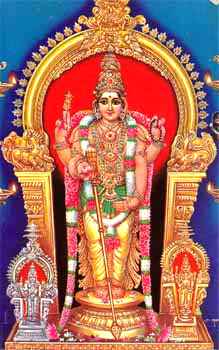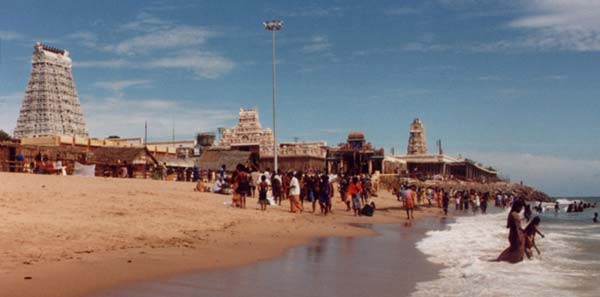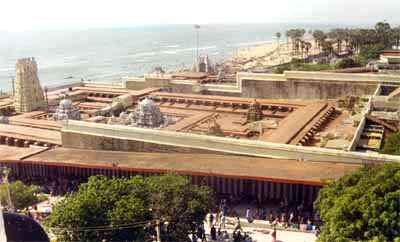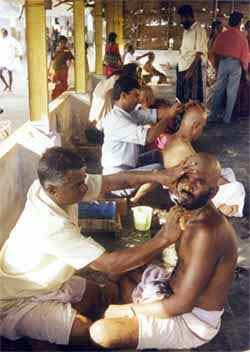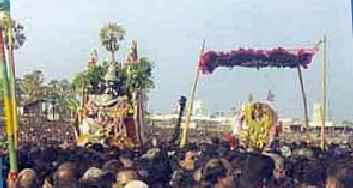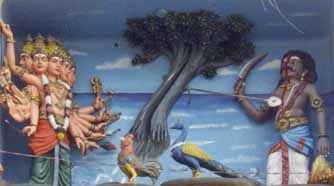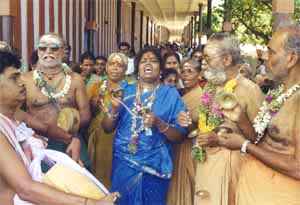
|
||||||||||||||
|
| ||||||||||||||
TiruchitambalamKanta Shasti VratamDr. T. SenthilverlKnow thy potential
Every one of us has the potential to realize God. We also have the potential to receive and transmit vital knowledge. We can attain the powers of seers. We can synthesize amirtam (elixir) in our body. All of us can hear the divine resonance Om and more, and see the divine in the form of brilliant light and see the vast luminescence space within us and in it everything. Know His whereaboutsIt has been said that: "Andattil
ullatu pindattil unddu
"That which is in the universe is in the body;
A healthy mind in a healthy bodySince God dwells within us it behoves us to keep the mind pure; and only a pure and healthy body befits a pure and healthy mind. Is it not for this reason that saint Tirumoolar, who gave us the priceless work Tirumantiram, said Udambinai
munnam illukendru irunhane
Tirumoolar says, "Previously, I thought that my physical body was a base burden and a despicable liability. Then, I realized that the essence of everything (God, Śivaperuman) dwells within my body, and, because my body is a temple for the Supreme One, I now value it and take intense and infinite care of it". Since God's abode (or, rather, one of God's many abodes) is the self, the way to God, or the path to the Divine is also within one's self. We care for the outer body by washing and cleaning. What about the inner body? All of us take in food. How many of us eat the proper food at the proper time in the proper quantity? The inner body is cleaned automatically by the elimination of waste, foreign matter and some substances that are in excess of immediate requirements. However, some essentials, for example fat, are stored for future use. During a time of shortage or when food is not taken in, stored fat sustains us. People who live in those parts of the world where periodic famines are experienced have a physique that is able to store considerable amounts of fat. Though stored fat can come to your aid when food from outside can become scarce, excess storage could prove to be a hindrance. Once in a while it is prudent to clean up the warehouse. Kanta Shasti Vratam – For a cleaner interior
Kanta Shasti Vratam is observed once a year in the month of ‘Aippasi' (October–November) starting from the ‘piratamai' the 1st phase of the brightening moon. Of all Kanta temples it is the one in Tirunchendur in Tamil Nadu, India that draws the largest number of Kanta devotees. All roads, at the time of the Vratam, seem to lead to Tirunchendur. Beside the temple by the sea there appears to be a sea of heads. The Kantan's Tiruvilaiyaadal (divine sport) Soora Samharam is enacted during the sixth day of the festival. This is a drama to grant a great boon to Curapatman by Kantan. Curapatman is given the honour of becoming Kantan's vehicle mayil vahanam (peacock vehicle) and ceval kodi (the rooster on Kantan's flag). During the six days of Kanta Shasti, devotees, usually fast. They fast in many different forms: some devotees take only one meal a day and that single meal is the evening meal; to some that single meal consist of fruit and milk; others forego all solid foods, even abstain from taking medication take only a liquid diet; some even forego the liquid diet. Of the above forms taking milk would defeat the purpose of clearing long stored fat. Not taking any liquids could be harmful, as many unwanted matters tend to remain in the body. The ideal form of fast would be that during all six days and nights to abstain from all solid food and even medicine but take water, coconut water, strained orange juice and or such permissible liquids. These liquids help to flush out unwanted substances and to clean the body. At the end of the six-day fast the body is indeed cleaner than it was before. The mind is cleansed by the pilgrimage, meditation, worship and other devotional activities. A pure mind in a pure body is a sublime combination and conducive to realizing the Divine. This is the reward and benefit of Kanta Shasti Vratam. The secret of fasting without experiencing the pangs of hunger
Many devotees, very much though they would like to undertake a complete fast, hesitate to do so at the thought of going without solid food for six days and six nights. Some devotees are concerned that the acidic digestive juices normally and habitually produced would irritate the lining of the stomach if there were no food for them to digest. If you are hungry and do not take food to assuage the pangs of hunger are you likely to develop stomach ulcers? In most cases, yes. However, vratam is a misunderstood word. It does not mean mere fasting. Literally, the Sanskrit word vrata means ‘vow'. By extension, it means adhering to certain principles and disciplines. This may include fasting, but does not have to include fasting. At the annual temple festivals in villages it is customary for everyone to skip at least one meal, and this meal is almost always the morning meal, or breakfast. The custom is almost universal and there is no choice in the matter of fasting; it is more or less compulsory. It should not be so; fasting should be voluntary. In those who undertake the fast unwillingly and without proper understanding there is hunger. Remember that, if you feel hunger, digestive acids are produced and the fast is broken. You might as well take food. More over it may not be appropriate to fast during all these festivals. There was a time when I doubted that I would be able to undertake the six-day Kanda Shasti fast. However, years ago, a calamity proved to be a blessing in disguise. It was just after my marriage. Just as any couple we too had our quota of oodal and koodal. During one of those oodal times, both of us hadn't talked to each other for two full days. At the end I realized I hadn't eaten anything during those two days. I had not felt hunger, in fact not thought of food, for two days. A truth dawned on me. It was a significant realization. If I could fast for two days then I could fast for six. I too could observe Kanda Shasti Vratam, specifically the fasting part of it. The success lies not in the denial of food but in refraining from all thoughts of it. The brain is prepared and preprogrammed (that is, the brain is told in so many words) not to expect food for the stomach for the next six days and, therefore, not to trigger the formation of chemicals essential for digestion. This is the secret how to fast without experiencing the pangs of hunger. I discovered that this truth is known to the Vedar (aboriginal hunters). I once had the opportunity of meeting a Vedan (aboriginal hunter) and taking him to my home in the city. The modern living conditions did attract his attention. He was quite at home, however he didn't show any attachment. I did ask him whether he along with his family would like to live with us for a good reason that he wouldn't have to go without meals at times like in the jungle. And here anytime you go downstairs to the dining hall you can have food. His reply surprised me. In spite of the comfort here he said he prefers the jungle habitat. He told me that he never felt hungry until he had food in his hands. That is he never thought of eating food until food was in his hands. He knew the secret of fasting and would not suffer the ailments that come from craving for or anticipating food. His wisdom may have been the common heritage of his people. The great siddhars are reputed to subsist on very little food. There are the great seers who go on for long periods apparently not taking food. They do not grow thin; they do not show signs of starvation as we lesser mortals would under the circumstances. These great ones have succeeded in arresting the aging process. If they attain siddhi at 50 years of age they look as if they are 50 years old even when they reach the age of 100. If siddhi is attained at 16 years, they retain the looks of a 16 year old even at 60 years or forever for that matter. Such siddhars, how do they manage not to eat for long periods not showing any signs of hunger, or starvation? They produce ‘amirtam' from within the body and that sustains them. During the vratam, the mind is focused on religious observances and due to pre programming the brain does not think of food; the brain is relaxed, as it does not have to cope with processing food for seven days. We are free to listen to, and to see the chittham and the ambalam within us. The Om nada (sound) we hear, we realize is the same sound at the time of creation created matter. We realize that Pillaiyar is the embodiment of the Om nada arising from the cosmic dance of the almighty. We also realize Kantan is the embodiment of the light of the almighty. Pillaiyar and Murugan are not different Gods but Śiva himself appearing in different forms. A God has no aati (beginning) or antam (end). The Param Porul has no birth or death. Some undesirable practicesDuring the period of Kanta Shasti Vratam many devotees recite Kanta Shasti Kavasam. These are verses asking Kanta for protection. In verse after verse, numerous parts of the body are mentioned as requiring protection, but many more parts, and, it must be mentioned, vital parts are left unmentioned. It has been said, "Ask, and it shall be given unto you". God always grants you what you ardently desire, so it might be prudent to ask for protection and leave it at that, and Kanda will protect your whole self. Moreover, in reciting Kanta Shasti Kavasam the devotees ask for the torture and destruction of kaala tootar. Such infliction or annihilation, if carried out according to your instructions and request, would detract from your current account of merit. Did not some of your wishes, or rather curses, take such forms as: "Kattu kattu kataridak kattu (tie them up, tie them up even as they scream) Katti uruttu kaal kai muriya (having tied them up roll them about so that their legs and arms break) Kuththu kuththu koor vadi velal (prick them, prick them with your sharp and resplendent spear) In another instance by reciting the Kanta Shasti Kavasam you are asking for the diffusion of the "manaiyil putaitta vancanai", evil crafts buried in the home compound. At times of distress, many are inclined to believe that evil forces have been set upon them by enemies. Some fear that the cause of all the distress, disunion, misery they are experiencing are due to their enemies having evil crafts buried in home compounds. Surely such things cannot be lying buried in all home compounds of all those who recite the Kanta Shasti Kavasam. In this instance as "Ask, and it shall be given unto you" God has to grant your wish. But how could He help to diffuse a buried evil craft when such a thing is not buried. However He is obliged to grant your wish. Prerequisite to fulfill your wish is initially an enemy who will have to bury the evil crafts in the home compound. Only then the evil crafts could be diffused. Imagine the complications. Until a decade ago, the Tiruchendur Kanta Shasti festival invitation cum programme bulletin printed every year included Kanta Shasti Kavasam. I explained the consequences to the temple authorities, who have since discontinued the practice and, instead, print "Tiruchendur Tiruppukal" and other inestimable hymns in praise of Kantan. There is another practice that needs reform. In enacting the Soora Samhaara Tiruvilayaadal the actors choose to jolt a live rooster vigorously. I appeal to those concerned to spare the rooster the pathetic ordeal. No harm should befall any peacock, rooster or for that matter any being and that too while enacting a Tiruvilaiyaadal. Tiru Chit AmbalamIn order to realize God you got to have a clear pure mind. A clean mind is conducive to realize that the path to the origin begins from within one's self. The tradition of saying Tiruchitambalam before and after singing holy hymns is particularly noteworthy. It is commonly understood that by saying Tiruchitambalam your are able to concentrate on the Tevaram, its meaning and effect. At the same time you are also able to focus your mind towards the centre of worship of Śiva at Tillai, commonly known as Chidambaram, in Tamil Nadu, India. Chidambaram is also known as Tillai Ambalam (the temple amidst tillai trees) because, in earlier days, the temple was surrounded by tillai (Excoecaria agallocha Linn) trees. Śiva, it is well known, is seen as the cosmic dancer, Nadaraja, in Tillai and is fondly known as Tillai Koottan. Though the word ganga means river, when mentioned unqualified, would refer to the river of rivers, the sacred Ganga, flowing from the holy Himalayas. Likewise, when it is unqualified, the word koyil, which means temple, denotes Tillai Ambalam. Rahasyam (Secret) ConcealedIn the minds of every Saiva is an urge to visit Chidambaram at least once in his lifetime. Many devotees would undertake a pilgrimage to Chidambaram, to see Śivaperuman as Nadaraja along with his consort Śivakama Sundari. You enter the koyil of the cosmic dancer Tillai Koottan. To his right is the area of Chitampara Rahasyam. The priest would invite you to glimpse the rahasyam. All you can see is a garland of a vilva (Aegle marmelos (L.) Corr.) leaves made of beaten gold. You are bound to appear puzzled or disappointed because you had hoped to see something marvelous and awesome. Where upon the priest will tell you firmly that that is the Chidamdara rahasyam. You will have to move away in order to make room for other eager devotees who have paid a fee to see nothing but nothing. In Chidambaram when you see Śivakama Sundari Samedha Nadaraja (Nadaraja with Śivakama Sundari) in the perambalam (big temple), you see him externally. Looking on at the space allotted as the Chidambara rahasyam you become alive to the fact that he is performing his cosmic dance of creation in the chit (small) ambalam (temple) of your chittam (mind). You see him internally. This is a reward and benefit of the pilgrimage. One can gain the same result, that is see Him internally, by intoning "Tiru chit ambalam"(the small temple) or Tiru chit ambalam (temple in your mind). The siddhars (great seers) achieved siddhi (success) by seeing in the chittam the Param. To see in the chittam (mind), Him, the Param in the luminous amparam (expanse) within one's self is the Chidambara rahasyam, the secret of secrets. It is worth emphasizing that the pilgrimage to the temple brings the same success to us. Uttering "Tiruchitambalam" also brings the same success to us. The supreme Siddhar dwells in our mind. Not only that, everything in the universe is within us. We realize that, indeed andattil ullatu pindhattil unddu. When we sing Tevaram with open eyes God cannot but appear before us. When we sing Tevaram with eyes closed we see Him Who dwells in our mind, in all His glory, internally. TiruchitambalamDr. T. Senthilwerl is a prominent Sri Lankan Tamil businessman and Murukan devotee. He is Trustee of five Murukan temples in Colombo. Dr. T. Senthilverl
See also Traditions of Tiruchendur and article "Pilgrimage and Mystical Practice" by the author.Tiruchendur.org official website of Śrī Subrahmanya Swami Devasthanam, Tiruchendur |
